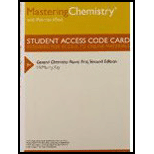
Interpretation:
The given compounds should be arranged in order of increasing solubility in pentane.
Concept introduction:
Polarity of any substance is measuring as dipole moment and solubility of any substance depends on the type of bonds present in it like polar and non-polar. According to the rule, like dissolve like, polar solute dissolve in polar solvent and non-polar solute dissolve in non-polar solvents.
Answer to Problem 12.1P
Solution:The order of increasing solubility in pentane is as follows:
Explanation of Solution
Polar organic compounds with less than six carbon atoms, low molecular weight, are soluble in both organic solvents and water.
Polar organic compounds with more than six carbon atoms, higher molecular weight, are soluble in organic solvents but insoluble in water.
There are following factors on which the solubility of solute in solvent depends:
| Solute | Solvent | |
| Polar | Non-polar | |
| Ionic | Soluble | Insoluble |
| Polar | Soluble | Insoluble |
| Non-Polar | Insoluble | Soluble |
Polar molecules: A polar molecule is known as dipole means with two poles positive and negative. The attraction force between positive pole of one molecule with negative pole of another molecule is called dipole force.
Non-polar: A non-polar molecule is a type of molecules where the electrons are distributed more proportionally and there is no charge at the opposite sides. The charges all cancel out each other. For examples hydrocarbon like benzene, toluene etc.
Toluene: Toluene, it is non-polar compound thus it is maximum soluble in non-polar solvent; pentane.
pentanediol: Due to the presence of hydroxyl group, it is slightly polar thus it is less soluble in non-polar solvent; pentane.
Therefore, the order of increasing solubility in pentane is as follows:
Want to see more full solutions like this?
Chapter 12 Solutions
Chemistry-Masteringchemistry With Etext
 ChemistryChemistryISBN:9781305957404Author:Steven S. Zumdahl, Susan A. Zumdahl, Donald J. DeCostePublisher:Cengage Learning
ChemistryChemistryISBN:9781305957404Author:Steven S. Zumdahl, Susan A. Zumdahl, Donald J. DeCostePublisher:Cengage Learning ChemistryChemistryISBN:9781259911156Author:Raymond Chang Dr., Jason Overby ProfessorPublisher:McGraw-Hill Education
ChemistryChemistryISBN:9781259911156Author:Raymond Chang Dr., Jason Overby ProfessorPublisher:McGraw-Hill Education Principles of Instrumental AnalysisChemistryISBN:9781305577213Author:Douglas A. Skoog, F. James Holler, Stanley R. CrouchPublisher:Cengage Learning
Principles of Instrumental AnalysisChemistryISBN:9781305577213Author:Douglas A. Skoog, F. James Holler, Stanley R. CrouchPublisher:Cengage Learning Organic ChemistryChemistryISBN:9780078021558Author:Janice Gorzynski Smith Dr.Publisher:McGraw-Hill Education
Organic ChemistryChemistryISBN:9780078021558Author:Janice Gorzynski Smith Dr.Publisher:McGraw-Hill Education Chemistry: Principles and ReactionsChemistryISBN:9781305079373Author:William L. Masterton, Cecile N. HurleyPublisher:Cengage Learning
Chemistry: Principles and ReactionsChemistryISBN:9781305079373Author:William L. Masterton, Cecile N. HurleyPublisher:Cengage Learning Elementary Principles of Chemical Processes, Bind...ChemistryISBN:9781118431221Author:Richard M. Felder, Ronald W. Rousseau, Lisa G. BullardPublisher:WILEY
Elementary Principles of Chemical Processes, Bind...ChemistryISBN:9781118431221Author:Richard M. Felder, Ronald W. Rousseau, Lisa G. BullardPublisher:WILEY





